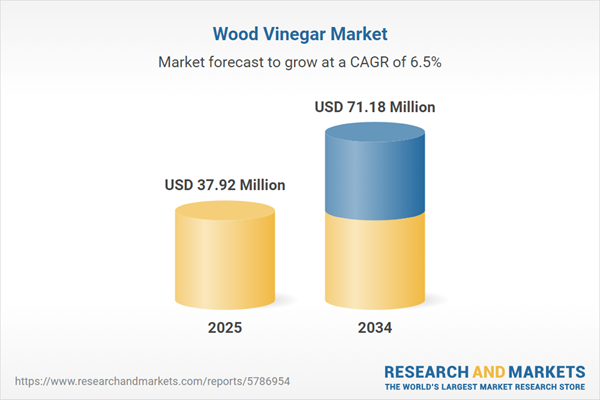Wood vinegar is known to have a bactericidal effect, and it can propagate microbes. Such benefits, coupled with its intrinsic properties, are boosting its usage to induce plant growth. In the agricultural sector, wood vinegar is widely used to reduce crop damage caused by diseases, stimulate plant rooting, regulate the nutrient condition of the soil, and optimise the microbiological population in the soil.
Figure: Distribution of Organic Agricultural Land: 2021
When added to the feed for cattle, wood vinegar helps improve their health, milk production capacity, meat quality, and fertility rate, allowing farmers to increase their profit. Furthermore, as wood vinegar is animal skin-friendly, it is used to effectively control the production of odour-causing bacteria on the animals, offering non-stimulating deodorisation and an environment that is healthy and fresh for livestock.In 2021, organic farmland grew to a total of 76.4 million hectares on a global scale. The rising concerns regarding health and environmental safety are contributing to a greater demand for organic agriculture produce, further necessitating the use of organic products and natural alternatives to chemical pesticides and fertilisers like wood vinegar.
Key Trends and Developments
Favourable government initiatives; rising research and development activities; increasing applications in the food sector; and rising demand for organic produce are impacting the wood vinegar market growth.Dec 2023
PyroAg encouraged Australian farmers to adopt sustainable farming practices, further lowering their fertiliser costs by eliminating its use in favour of organic products like pyroligenous acid or wood vinegar, positioning itself as its prominent supplier to combat rising fertiliser costs.Jun 2022
Two inventors from Beit Hanoun in the northern Gaza Strip have developed a wood vinegar distillation device that is highly beneficial for farms struggling with high salinity in irrigation and pesticide use.Dec 2021
Agriculture and Agri-Food Canada announced its investment of up to USD 297,330 towards the Prairie Organic Development Fund (PODF) to support farmers in improving organic farming practices and meeting the growing demand for organic foods in the country.Rising research and development activities
Growing research activities are expected to stimulate the use of wood vinegar in medical applications to reduce acid reflux, heartburn, and indigestion; prevent vomiting; reduce peptic ulcers; and eliminate dental infections; among other conditions, leading to the wood vinegar market development.Growing applications in the food sector
There is a rising use of wood vinegar in the food industry as a flavour additive and preservative for aroma and food, as it is known to contain anti-microbial and antioxidant properties. The presence of phenolic compounds in wood vinegar contributes to its antimicrobial characteristics.Increasing adoption of organic farming
The rapidly growing organic agriculture sector is driving the demand for wood vinegar as one of the most sought-after organic fertilisers used in agricultural practices. Wood vinegar is used to improve soil quality, eradicate pests, and promote plant growth.Favourable government initiatives
Governments globally are laying out schemes and initiatives as part of their plans to boost sustainable agricultural practices and provide more income to farmers. For instance, the U.S. Department of Agriculture’s (USDA) Organic Transition Initiative, launched in 2022 to promote organic farming practices, is anticipated to potentially support the use of wood vinegar as an organic fertiliser in farming.Wood Vinegar Market Trends
The expanding global population supports the demand for animal protein obtained from meat, milk, and eggs. The production of safe and nutritious animal food is dependent on feed quality. Consequently, the demand for wood vinegar is anticipated to rise in animal feed. Studies have depicted the positive impact of wood vinegar on cattle meat quality and fertility rate, milk production and quality of eggs.Consistent supply of wood vinegar is important for the supply of biomass, particularly wood. In this regard, regions that have a well-established forestry industry or an abundance of agricultural waste in general can offer the advantage of lesser raw material costs along with a continuous supply.
The rapidly rising biomass wastes globally are contributing to disposal and governance issues. As a result, the abundant biomass waste can be used to produce wood vinegar and support global sustainability.
Moreover, rising health concerns among the population are accelerating the shift towards organic food products that are chemical free and eco-friendly. Hence, there is an increase in the use of organic fertilisers, such as wood vinegar produced from renewable sources, to enhance the growth and strength of roots.
Market Segmentation
“Global Wood Vinegar Market Report and Forecast 2025-2034” offers a detailed analysis of the market based on the following segments:Market Breakup by Pyrolysis Method:
- Slow Pyrolysis
- Intermediate Pyrolysis
- Fast Pyrolysis
Market Breakup by Application:
- Agriculture
- Animal Feed
- Food, Medicinal, and Consumer Products
- Others
Market Breakup by Region:
- North America
- Europe
- Asia-Pacific
- LAMEA (Latin America and Middle East and Africa)
Based on application, agriculture dominates the wood vinegar market share
In vegetable cropping, wood vinegar finds use in producing high-quality vegetables by combating diseases and acting as a seed germination accelerator. Additionally, it is often used in orchards, to boost the number of fruits produced. The rising demand for organic food products supports the use of wood vinegar in organic agriculture to replace toxic chemical pesticides and fertilisers to improve soil quality and eliminate pests.As a supplement for livestock feed, wood vinegar can adjust bacterial levels in the animal's digestive tract, thereby enhancing nutrient absorption from the feed.
In the food sector, wood vinegar provides food with a smoky aroma, which supports its use in countries like the USA to produce food products. Additionally, its antimicrobial and antioxidant properties aid its application in preserving foods, such as meat and fish.
Wood Vinegar Market Analysis by Region
In alternative medicine in countries like South Korea, China, and Japan, among others, wood vinegar has been used as a prebiotic to improve gut health.Organisations such as Woodvinegar.org in the US aim to create awareness regarding wood vinegar and organic fertilisers and connect farmers with the resources they need, to promote the development of an ecologically sound food system, further aiding the wood vinegar market growth in the region.
Brazil-produced pulverised coal is widely used in the production of wood vinegar. Further, there is a rising use of eucalyptus wood vinegar in food, agriculture, and veterinary sectors in the country. The Brazilian poultry sector serves around 40% the total chicken meat consumed in the world and is also among the leading exporters of beef and pork. This sector is expected to drive the demand for wood vinegar to improve digestion and enhance nutrient absorption in livestock.
Competitive Landscape
The market players are focusing on improving product quality, pricing, distribution, and marketing strategies to gain a competitive edge.ACE (Singapore) Pte Ltd
Headquartered in Peninsula Plaza, Singapore, the company specialises in wood vinegar, feed grains and meals, fertilisers, feed additives and food commodities.Tagrow Co., Ltd
Tagrow Co., Ltd., with headquarters in Beijing, China provides comprehensive range of products including wood vinegar, amino acid, humic acid, and granular fertiliser, among others.Sane Shell Carbon Private Limited
Based in Karnataka, India, the company offers wood vinegar, coconut shell charcoal, pyroligneous acid, and wood tar.Nettenergy B.V.
Established in 2006, the company provides biochar, wood vinegar, pyrolysis oil (dry and wet), and syngas, among others.
Other notable players operating in the wood vinegar market include New Life Agro, and Applied Gaia Corporation, among others.
Table of Contents
Companies Mentioned
The key companies featured in this Wood Vinegar market report include:- Ace (Singapore) Pte Ltd
- Tagrow Co., Ltd.
- Sane Shell Carbon Private Limited
- Nettenergy B.V.
- New Life Agro
- Applied Gaia Corporation
Table Information
| Report Attribute | Details |
|---|---|
| No. of Pages | 168 |
| Published | August 2025 |
| Forecast Period | 2025 - 2034 |
| Estimated Market Value ( USD | $ 37.92 Million |
| Forecasted Market Value ( USD | $ 71.18 Million |
| Compound Annual Growth Rate | 6.5% |
| Regions Covered | Global |
| No. of Companies Mentioned | 7 |









